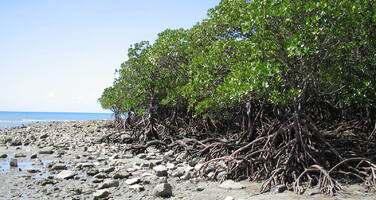Wet Tropics of Queensland
Factors affecting the property in 2001*
- Ground transport infrastructure
- Interpretative and visitation facilities
- Invasive/alien terrestrial species
- Management systems/ management plan
- Other climate change impacts
- Water (extraction)
Factors* affecting the property identified in previous reports
- Lack of funds (issue resolved);
- Delayed planning process (issue resolved);
- Hydropower development project (issue resolved);
- Need for a comprehensive assessment of the issues at the sites and a conservation plan (issue resolved)
International Assistance: requests for the property until 2001
Total amount approved : 0 USD
Missions to the property until 2001**
Information presented to the Bureau of the World Heritage Committee in 2001
Previous deliberations:
Twenty-fourth session of the Committee: page 111 in Annex X
Twenty-fourth extraordinary session of the Bureau: paragraph I.5
Main issues: implementation of management and strategic plan, monitoring of introduced species, management of land use and human impacts.
New Information: The State Party, via a letter dated 18 April 2001, has transmitted to the Centre its response to the priority action areas described in ACIUCN report that was reviewed by the twenty-fourth extraordinary session of the Bureau. The State Party response has been transmitted to IUCN for review.
Action Required
The Bureau may wish to review IUCN comments and observations on the Australian Government response to the priority action areas identified in the ACIUCN report at the time of its session and take appropriate decisions.
Summary of the interventions
Decisions adopted by the Committee in 2001
25 BUR V.116-118
Wet Tropics of Queensland (Australia)
V.116 The Bureau noted that the State Party, via a letter dated 18 April 2001, has transmitted to the Centre its response to the priority action areas described in the ACIUCN Report that was reviewed by the twenty-fourth extraordinary session of the Bureau. The State Party response has been transmitted to IUCN for review.
V.117 The Delegate of Australia informed the Bureau that it was developing a proposal for the information of the Committee in Helsinki in December, 2001, that would rename the property Australia’s Tropical Rainforests.
V.118 The Bureau thanked the Government of Australia for responding to the recommendations of the ACIUCN Report on the state of conservation of the Wet Tropics of Queensland, reviewed by the Bureau in Cairns, Australia, in November 2000. The Bureau noted the achievements and the commitments of the State Party and invites the State Party to finalise its on-going consideration of the implementation of some activities by the Commonwealth and the Wet Tropics Ministerial Council. The Bureau invited the State Party to consider linking monitoring activities in the Wet Tropics of Queensland to the UNESCO/IUCN/UNF-UNFR project testing the application of tools for evaluating management effectiveness in 10 other World Natural Heritage sites of the world. The Bureau requested that the State Party and IUCN continue to collaborate to develop a Framework for Management as a basis for monitoring annual progress in the implementation of the five Focused Recommendations outlined in the ACIUCN Report. The Bureau recommended that the first report on progress in the implementation of the five Focused Recommendations be compiled within the context of the periodic reporting on Asia Pacific World Heritage sites scheduled for 2002/2003.
Exports
* :
The threats indicated are listed in alphabetical order; their order does not constitute a classification according to the importance of their impact on the property.
Furthermore, they are presented irrespective of the type of threat faced by the property, i.e. with specific and proven imminent danger (“ascertained danger”) or with threats which could have deleterious effects on the property’s Outstanding Universal Value (“potential danger”).
** : All mission reports are not always available electronically.


